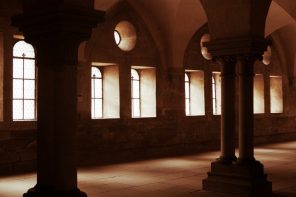Each Sunday, I have the privilege of worshipping in a beautiful church building, surrounded by stained glass windows that image the Biblical narrative of the life of Jesus. Because of where I sit during the service, my backdrop tends to always be a particularly striking image of Christ on the cross. I’m not an expert in stained glass but as an artist, I can appreciate the work for its form, its composition, and its aesthetic value. As a student of theology, I can appreciate it for how it images the Biblical narrative. And if we return to discussions in previous posts, the ‘uselessness’ of the art happens when the midday sun strikes the window and sends shards of vibrant colours across the worshipping community, somehow connecting us to both the story in the window but also the Creator who makes the sun to shine.
While artists and theologians discuss the appropriate engagement between theology and the arts, many Christians sit surrounded by art that has existed in the church for centuries. For the sake of discussion, let’s consider the stained glass. Stained glass windows sit within a tradition of communication—in many churches, they were created as teaching tools for those who could not read. However, their execution is gratuitous—many are incredibly intricate, beautiful, and witness to the skill and work of the artists who participated. Created to be beautiful because the story they are presenting is beautiful. However, do congregations have ‘eyes to see’ that which is around them? Or has the stained glass, at least in my church, become just ‘part of the furniture’, ceasing to capture the gaze or understanding of those who worship?
Would engagement be furthered through an education of the congregation on the beauty that surrounds them? As a church community, we have lost the visual language embedded in these works, thus we are not able to understand the symbols or the unique way in which the artisan has chosen to fashion the story together. In a recent conversation with a colleague, it was suggested that education of the church would help to right the seeming inability for some Protestant churches to allow for art’s uselessness rather than reducing art to useful ends – as we become skilled to ‘see’, we come to appreciate the beauty rather than just the message. Perhaps a course in ‘Art Appreciation’ is in order – bringing in someone who is knowledgeable to lecture or even creating a leaflet with information that someone can use as they wander around the church.
I’m sure that some of those things would be helpful in raising awareness and the desired appreciation for the work that surround them. However, I want to suggest a second way for engagement that I think could be more fruitful – that of ‘Art Participation’. In the same way that works of participatory art invite the viewer to enter the art and participate in its creation to give the viewer an experience that changes the way they see the world around them, is there similar opportunity in arts engagement? While we cannot physically alter something like a stained glass window, I wonder what it would look like if we engaged in understanding the art in this way – entering into the work as a congregation, discussing what it means now for the individual and the community, and together appreciating its beauty and its message. This moves beyond just appreciating the art based on being educated but understanding the art because we participate as a community within it. And perhaps by understanding and participating in the art they see every week, the church will develop the ‘aesthetic sensibility …that is able to generate creativity’ as well as appreciate art for both its use and ‘uselessness’.




